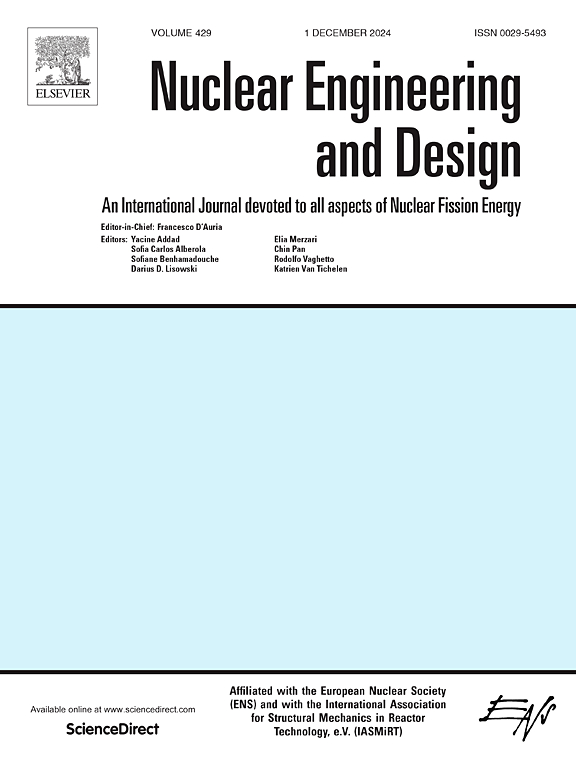木材金属在水中破碎的三维数值研究及粒度分布估算
IF 2.1
3区 工程技术
Q1 NUCLEAR SCIENCE & TECHNOLOGY
引用次数: 0
摘要
在核反应堆发生严重事故时,熔融核燃料可能在反应堆容器内以射流的形式与液体冷却剂相互作用。本文研究了模拟堆芯材料木屑金属在水中的水动力破碎。利用开源DNS求解器Basilisk代码开发了三维数值模型,并与文献中低温Wood’s金属水系统的实验结果进行了验证,误差约为2.3%。采用流体体积(Volume of Fluid, VOF)技术捕获液-液界面,采用自适应网格细化(Adaptive Mesh Refinement, AMR)技术减少计算时间。从网格精细化层次的敏感性研究出发,选择精细化层次12,在精度和计算时间之间取得平衡。研究了碎块沿水平方向和垂直方向的质量和大小分布。通过改变射流初始速度对颗粒破碎和粒径分布的影响,进行了参数化研究。估计了所有情况下的分离质量分数和粒度分布,并在碎片的MMD与Weber数之间建立了相关性。本文章由计算机程序翻译,如有差异,请以英文原文为准。
3D numerical investigation of fragmentation of wood’s metal in water and estimation of particle size distribution
During a severe accident in a nuclear reactor, the molten nuclear fuel may interact with the liquid coolant in the form of jet in the reactor vessel. In this work hydrodynamic fragmentation of the Wood’s metal which is a simulant material for corium in water is studied. The 3D numerical model is developed in the open-source DNS solver Basilisk code and validated with experimental results found in literature for low temperature Wood’s metal water system with a discrepancy of about 2.3%. Volume of Fluid (VOF) technique is adopted to capture the liquid–liquid interface and Adaptive Mesh Refinement (AMR), to reduce the computational time. From the sensitivity study on mesh refinement levels, refinement level 12 is chosen, striking a balance between accuracy and computational time. The mass and size distributions of the fragments along the lateral and vertical direction are also studied. A parametric study has been carried out by varying the jet initial velocities to study its influence on the break up and particle size distribution. Detached mass fraction is estimated and particle size distribution is obtained for all the cases and a correlation has been developed between the MMD of the fragments and Weber number.
求助全文
通过发布文献求助,成功后即可免费获取论文全文。
去求助
来源期刊

Nuclear Engineering and Design
工程技术-核科学技术
CiteScore
3.40
自引率
11.80%
发文量
377
审稿时长
5 months
期刊介绍:
Nuclear Engineering and Design covers the wide range of disciplines involved in the engineering, design, safety and construction of nuclear fission reactors. The Editors welcome papers both on applied and innovative aspects and developments in nuclear science and technology.
Fundamentals of Reactor Design include:
• Thermal-Hydraulics and Core Physics
• Safety Analysis, Risk Assessment (PSA)
• Structural and Mechanical Engineering
• Materials Science
• Fuel Behavior and Design
• Structural Plant Design
• Engineering of Reactor Components
• Experiments
Aspects beyond fundamentals of Reactor Design covered:
• Accident Mitigation Measures
• Reactor Control Systems
• Licensing Issues
• Safeguard Engineering
• Economy of Plants
• Reprocessing / Waste Disposal
• Applications of Nuclear Energy
• Maintenance
• Decommissioning
Papers on new reactor ideas and developments (Generation IV reactors) such as inherently safe modular HTRs, High Performance LWRs/HWRs and LMFBs/GFR will be considered; Actinide Burners, Accelerator Driven Systems, Energy Amplifiers and other special designs of power and research reactors and their applications are also encouraged.
 求助内容:
求助内容: 应助结果提醒方式:
应助结果提醒方式:


